What is a cam based focus system?
Cam-based vs helicoid focus system?
When discussing different rehousing projects, you’ll often come across the terms ‘cam-based’ or ‘helicoid’ focus systems. These phrases are not unique to the rehousing of lenses either. Manufactures use these systems to create the focus movements for modern day lenses too. However, which system is the best to use and what are the pros and cons of both? To make an informed decision, you’ll need to know the key differences between these and what it means for the purchaser.
Helicoid system
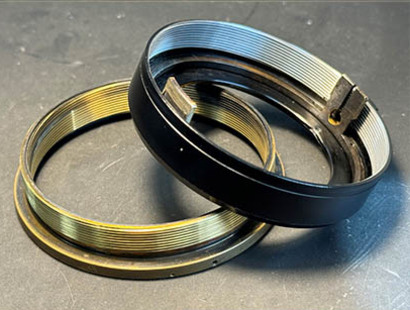
Traditionally, the helicoid system is the most prominent used system within the cine lens world (as well as most vintage stills lenses too). In almost all designs of lens mechanics, when a helicoid system is used, it is in the form of a thread. Much like what you’d expect to see on a bolt, but on a larger scale. The helicoid refers to the trait that the movement is linear/on a constant pitch throughout the movement. Therefore, the rotation of the focus barrel will directly correspond to the amount of fore/aft movement of the optical block(s). To stop the optical unit rotating when focus is pulled, there are ‘keys’ (sometimes referred to as ‘dogs’) integrated into the mechanical system. These are generally thin, flat sections of metal that are connected to the main chassis/housing of the lens. The part that needs to move fore/aft will have slots in that match the width of the keys. Therefore, as the focus is rotated, one section slides fore/aft along the length of the keys, preventing the rotation of the optical unit(s).
These systems can become quite complicated when floating elements are involved. As the different optical units need to move at different speeds (and sometimes different directions), it requires the use of different pitched threads and two sets of keys, a pair for each moving optical unit. Therefore, the rear group might be moving on a 0.75mm pitch thread and the front group on a 0.5mm pitch thread.
The advantage of the threaded helicoid system is that it is relatively easy to manufacture, especially if higher quantities are needed. Furthermore, the skill needed to assemble these lenses are not as high as that of a cam-based system.
The main disadvantage of the threaded helicoid system is wear. As the lens is used, the metal threads run against each other. Over time, this causes wear, especially when contamination (such as dust or sand) ingresses into the mechanics. This wear means that the threads no longer fit perfectly to each other, resulting in backlash in the focus system.
Another disadvantage is the tolerances needed for this system to work well are very high. Therefore, if there is any distortion on the focusing section, it can cause multiple issues. If the lens takes a knock or impact damage to the focus section, it can cause the focus movement to feel uneven, tight or bind up completely. This is difficult to repair without replacing parts.
As the helicoid system is linear, this means that the movement of the optical block(s) is constant. Therefore, the focus marks are generally quite spread out at close focus and are closer together towards the infinity end. This makes the lenses much less user friendly on set, especially if the amount of rotation is already limited with the mechanical design.
Cam-based system
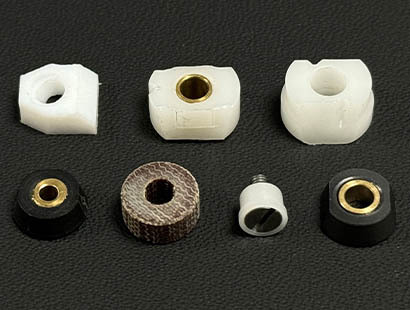
A cam-based system is one where the rotating part of the focus movement has a slot, and the fore/aft movement is driven using a ‘follower’. The follower is usually made from a bearing grade plastic (although sometimes miniature bearings are used) to run up and down the length of the slot as the focus is rotated. There are many different forms of cam-based focus systems. Some use a slot with square edges and a follower that is an exact fit. More complicated systems will use an angled slot with angled flanks on the follower. In this case a sprung loaded follower is needed to keep it pushing into the angle of the slot.
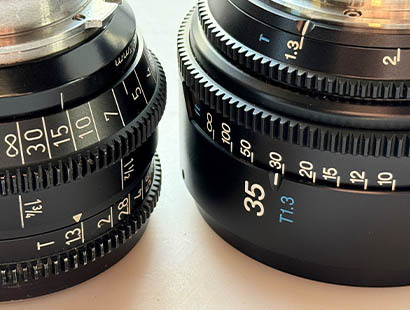
The main advantage of using a cam-based system is when the cam is non-linear. Therefore, the fore/aft movement of the optical unit(s) does not directly relate to the rotation of the focus barrel. This allows the mechanics of the lens to slow the fore/aft movement towards the infinity end and accelerate the fore/aft movement towards close focus. This gives a greater spread of focal distances on the focus scale. This results in smaller gaps between the closer focus marks and greater gaps between the longer focus marks, giving the lens much greater useability.
Another advantage for the cam-based system is that the focus rotation can be increased. Generally, cam-based systems will have around 300 degrees of focus rotation, often superseding that of the original helicoid system that was used. This gives greater focus control to the end user of the product.
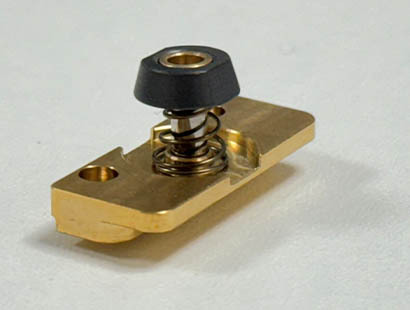
Cam-based focus systems, when designed well, offer much better protection against backlash and image shift as well. This is especially true for the systems that use a sprung loaded follower with an angled cam slot. However, there are some difficult design and manufacturing process involved to get this right.
This is where some of the disadvantages of the cam-based system come in. If the system does not use angled slot(s) with a sprung loaded follower, the follower must be an exact fit into the slot. Otherwise, backlash will be introduced. Furthermore, if/when the follower begins to wear, this will again introduce backlash into the focus system.
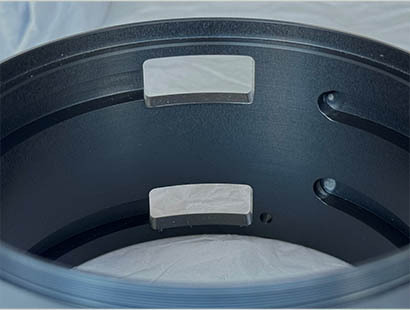
When using a cam-based system, the fore/aft movement of the optical units is critical. They must be aligned correctly, but also not have any lateral movement within the system. If there were any lateral movement, this would introduce image shift and possibly some backlash too. This means that the tolerances in machining must be high.
Due to the care needed in the design and manufacturing process of a cam-based system, this escalates the costs significantly over that of a helicoid system. This is especially true when using a non-linear cam-based system. To design and manufacture the mechanics to be reliable, repeatable, and robust means hours of research and development as well as a skilled team to manufacture and build the lenses. This all leads to a premium price that doesn’t suit all budgets.
Summary
As you can see, both systems have their advantages and disadvantages. One needs to weigh up the value that would be gained from them with either of these systems and choose which one is suitable. It also highlights that some research is needed to make sure you’re getting the benefits you might expect from a cam-based system as there are different levels under this one name. However, if budget isn’t the deciding factor, then a non-linear cam-based system provides many benefits over the others.
For more specifics on our rehousing process and what you can expect from TLS, please get in touch with us at sales@truelens.co.uk or calling our office on +44 (0)1455 848411.






